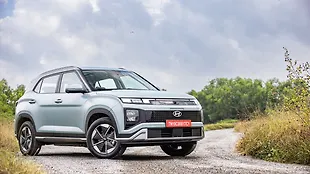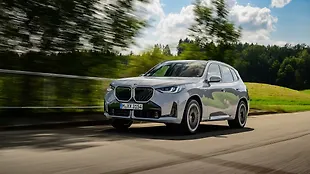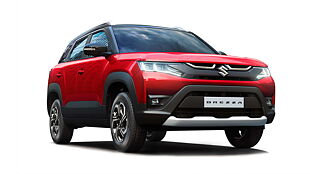Introduction

With our cities getting crowded and traffic congestion increasing, driving is getting difficult with each passing day. The need for an automatic has grown over the years, especially in bumper-to-bumper traffic when one has to constantly press the clutch and shift gears. Small wonder then that cars with automated manual transmission (AMT) have gained so much of popularity. One, for the ease it provides with clutchless gearshifts and two, for being far more affordable than conventional automatic gearboxes. Pair this with an entry-level hatchback and it addresses all the afore-mentioned worries that come with a family car. This formula has definitely worked and is now being used in two cars that are now a household name in any Indian family - the Hyundai Santro and the Maruti Suzuki WagonR.

Both monikers are old, but both cars are in their new-gen avatar. They are built on a new platform, boast of a new design, new features, bigger cabin and so much more than their predecessors. Plus, with the availability of an automatic variant, entry-level car buyers are in a dilemma over which one to choose. This is where our extensive road test of these models will give you a clear idea of which one makes a better proposition.
Size and appearance

The WagonR is the newer car that was launched this year. It's completely new from the ground-up, and yet manages to retain the WagonR's original avatar. That said it's not boxy. In fact, its rounded edges making it a fairly good-looking car. In its third-generation, it’s built on a new platform and is bigger and better than its outgoing model. Its front end sports a new grille along with nicely shaped headlamps and a new bumper with a trapezoidal housing for the fog lamps. The rear too benefits from a complete re-jig as well, with new elongated tail lamps giving it a modern and mature look.

The Santro, on the other hand, was launched last year, marking its comeback after it was first launched 20 years ago in India. It’s bigger than the outgoing model, but still smaller in dimensions than the WagonR. In terms of design, the swept-back headlamps, large grille, a tall-boy stance and uninteresting rear don't add that much flair. And despite the flared wheel arches and creases on the body, there isn’t anything that makes it look very attractive.
Cabin Comfort and Space

Still, compared to the original Santro, this new one has a larger cabin thanks to its new platform. In fact, at the time of its launch, it was the most spacious car in its class. But then, the new Wagon R is now built on the Heartect platform, which also underpins the Baleno and the Swift, making the car bigger in terms of dimensions and space. This translates into great headroom inside the cabin although the Santro’s is still respectable. Both cars don’t get seat height adjustment. Yet, Hyundai hasn’t equipped it with an adjustable steering wheel, meaning tall people are going to have trouble finding the perfect driving position. That’s not the case with the Maruti, although, with steering that can be adjusted for rake. A large glasshouse in both cars provides a good view of the road ahead. Only the rearward visibility in the Santro is hampered owing to the smaller rear windscreen.

The front seats are accommodating and nicely contoured providing adequate support. Hyundai has paired the fabric material with rexine to give it a more upmarket feel. An ergonomically laid out dashboard with quirky looking ac vents and a large touch screen means that even the controls are within arm’s reach. Meanwhile, the WagonR’s cabin also has a decent design, but the hard plastics, the texture, finesse and the feel aren’t as good as the quality of materials used in the Santro. In the latter, it feels so much better, in fact, similar to cars from a higher segment, like the Grand i10. We still would have liked the placement of switches for power windows in the conventional door-pads instead of the centre console.

Moreover, storage places are sufficient in both cars with decently sized glove-boxes, four bottle holders and smartly managed stowage slots in the dashboard and centre console. In the back seat, one might think that the Santro’s roof sloping backwards might hinder the rear headroom. Of course, it isn’t as generous as the WagonR but ample enough for average heighted individuals. Surely, the Maruti with more headroom, shoulder room and knee room is more spacious than the Santro and compliant for three occupants. Yet, the Santro’s seats are nicely inclined, provide more thigh support and the beige door pads give it a roomier feel. What’s more, the rear ac vents are a first-in-segment feature which add to the comfort. Still the WagonR beats the Santro in the boot space department with 106 litres of additional boot space. It also gets a split-fold seat adding to the versatility.

Decked up?

Gone are the days when creature comforts could only be found in cars from the higher segment. Now entry-level cars also boast of equipment for comfort, safety, convenience and infotainment needs. Both these cars are no different. Most notable is the new infotainment system previously unseen on any Maruti. This SmartPlay Studio system has an easy-to-use and nice-looking interface supporting Android Auto and Apple CarPlay. Sure, the Santro’s touch screen might not be as colourful as the home screen on the WagonR, but it does support Mirrorlink.

The other bits are common like central door locking, power windows, electrically adjustable ORVMs, a comprehensive trip computer, steering mounted audio controls, USB, 12V charging ports amongst others. In fact, the WagonR also gets an external boot-release. Still one thing that left us wanting for more in both cars is the option of alloy wheels. Nonetheless, safety wise, both cars are equipped with a driver-side airbag. And yet, the WagonR surpasses it with an additional passenger side airbag and rear parking sensors.
On the road

The biggest change in the new Wagon R is a four-cylinder 1.2-litre petrol engine offered for the first time along-side the already existing three-cylinder 1.0-litre engine option. Here, this 1.2-litre motor churns out 82bhp and 113Nm of torque as compared to its 1.0-litre counterpart producing 67bhp and 90Nm. Both engines are mated to a five-speed gearbox with the option of AMT. On the other hand, the Santro comes powered by a heavily reworked version of the Santro Xing’s 1.1-litre, four-cylinder Epsilon petrol engine that offers 69bhp and 99Nm of torque in its current guise. Apart from a five-speed manual, one may avail of this five-speed AMT, which marks the debut of AMT technology for Hyundai.

Both the engines are equally silent, however, the Santro’s unit feels more refined. Moreover, its engine noise doesn’t filter into the cabin. That said, it gets quite audible in both cars post 4,000rpm. Now as on paper, the difference in the power also clearly shows right when you get off the mark. The WagonR feels quicker and the extra power helps it get going faster than the Santro. Both take their sweet time at low rpms but it’s in the mid-range where the WagonR feels stronger. Comparatively, the Santro’s engine feels like it needs to be worked upon a bit to squeeze out performance from it. But it’s probably because Hyundai has tuned the motor to be energy efficient over everything else. But does it make up for a lot of ground? We will get to that in our fuel efficiency tests.

Now, let’s get to the AMT gearboxes. They undoubtedly provide relief in traffic snarls. Both cars move ahead smoothly as soon as you let go off the brakes, but the WagonR has a stronger tug. The Santro’s AMT still offers relatively smooth gearshifts. In the WagonR, the head nod on gear-shifts is pronounced, whereas this has been contained well in the Santro, resulting in a smoother drive. Comparatively, the WagonR’s gearbox is more responsive and doesn’t require the need to shift manually at times as in the Santro. That said, both feel a bit slow on open roads whether it’s for upshifting or downshifting. This is a characteristic AMT trait where it takes a bit of time to recognise driver’s input. Still one has the option of changing gears manually, which will help in getting more control while going down a slope or planning to overtake.

For the ride and handling bit, both these cars with a tall-boy design have a compact footprint ideal for city dwellings. And though these are not really fun to chuck around corners, both are predictable handlers with light steering. These weigh up adequately at high speeds, still, the artificial response in the Santro hampers the feel. The WagonR feels better with a more fluid and smooth response. Unlike the Hyundai which feels more planted, Maruti’s hatchback is taller and hence the body roll in the latter is more pronounced too. Suspension duties are done by McPherson struts upfront and torsion beams at the rear, which are nicely tuned to absorb shocks, especially to iron out road imperfections. That said, the Santro’s set-up manages to absorb shocks better, especially sharper potholes and road joints. But when you pick up the pace, the soft tuning makes for a springy ride that gets uncomfortable for rear passengers. The WagonR, on the other hand, is relatively stiffer and provides a flatter ride at higher speeds. There’s no particular difference on the braking front and both cars have enough stopping power and tyre grip with similar profiles of wheels and rubber.

Acceleration and in-gear tests

According to our VBOX figures, the Santro took a lazy 17.64 seconds to complete the 0-100kmph run, while the WagonR did it in just 13.94 seconds. And again, when it came to the crucial test of driveability, the Maruti won in the roll-ons too. The 20-80kmph in kick-down was completed 1.97 seconds faster and similarly it was quicker by 2.62 seconds in the 40-100kmph run. This clearly goes to show the difference in the pulling power of the two cars. Meaning the WagonR will overtake quickly, all thanks to the extra power and lighter weight.

Fuel efficiency

Fuel efficiency figures in real world conditions vary from the ARAI-claimed numbers. Yet we tested both these cars in the same conditions and results show a very small difference. The Santro returned 11.41kmpl in the city with the WagonR not too far behind at 10.69kmpl. Interestingly, it's the Maruti Suzuki that returned 19.41kmpl on the highway, better than the Hyundai trailing at 17.7kmpl.

Verdict

Rank 2 Hyundai Santro Sportz AMT
Final Score – 361
Price – Rs 6.44 lakhs (on-road Mumbai)

Even though the Santro might not be very good-looking but is still a good overall package. It’s impressive with its interior design, segment-first features, better quality interiors, refined engine and a smoother gearbox. Still, it couldn’t match up to the performance and interior space of the WagonR.
Rank 1 Maruti Suzuki WagonR ZXi AMT
Final Score – 372
Price – Rs 6.79 lakhs (on-road Mumbai)

The WagonR wins this test by a good margin because of its better engine performance and larger cabin. Sure it could do with a better NVH cabin insulation and better use of plastics inside. But other than that it’s hard to find fault with. Its price is also justified for the extra features and safety equipment. And how can we forget Maruti’s brand and resale value? Needless to say, if you had to choose between the two, we think you should make space for the WagonR in your parking lot.
Pictures by Kapil Angane
Specifications
| CAR NAME | Maruti Suzuki WagonR | Hyundai Santro |
| Variant | ZXi AMT | Sportz AMT |
| ENGINE | ||
| Fuel | Petrol | Petrol |
| Installation | Front, transverse | Front, transverse |
| Displacement | 4 cyls, 998cc | 4 cyls, 1086cc |
| Power | 82bhp at 6000rpm | 68bhp at 5500rpm |
| Torque | 113Nm at 4200rpm | 99Nm at 4500rpm |
| Power to weight | 96.47bhp per tonne | 73.91bhp per tonne |
| Torque to weight | 132.94Nm per tonne | 107.6Nm per tonne |
| Gearbox | 5-speed AMT | 5-speed AMT |
| CHASSIS & BODY | ||
| Kerb weight (measured) | 850kg | 920kg |
| Tyres | 165/70 R14 | 165/70 R14 |
| Spare | Full-size | Full-size |
| STEERING | ||
| Type | Rack and pinion | Rack and pinion |
| Type of assist | Electric | Electric |
| Turning circle | 4.7 | - |
| BRAKES | ||
| Front | Discs | Discs |
| Rear | Drums | Drums |
| ABS | Yes | Yes |
Test Data
| CAR NAME | Maruti Suzuki WagonR | Hyundai Santro |
| Variant | ZXi AMT | Sportz AMT |
| PERFORMANCE & BRAKING | ||
| 0-20kmph | - | - |
| 0-40kmph | 3.8s | 3.63s |
| 0-60kmph | 6.19s | 7.39s |
| 0-80kmph | 9.84s | 12.11s |
| 0-100kmph | 13.94s | 17.64s |
| 0-120kmph | 20.44s | 27.67s |
| 20-80kmph in 3rd gear (kickdown) | 8.23s | 10.20s |
| 40-100kmph in 4th gear (kickdown) | 10.03s | 12.65s |
| 80-0kmph | 27.44m | 28.99m |
| FUEL ECONOMY | ||
| City | 10.69kmpl | 11.41kmpl |
| Highway | 19.41kmpl | 17.7kmpl |
| Tank size | 32 litres | 35 litres |
| Range | 403.96km | 431.98km |
| INTERIOR MEASUREMENTS | ||
| Front | ||
| Legroom(Max/min) | 860/630mm | 820/650mm |
| Headroom | 960mm | 990mm |
| Shoulder room | 1280mm | 1270mm |
| Backrest height | 580mm | 600mm |
| Rear | ||
| Legroom(Max/min) | 850/650mm | 820/630mm |
| Ideal legroom | 630mm | 720mm |
| Headroom | 920mm | 940mm |
| Shoulder room | 1320mm | 1240mm |
| Seat base length | 480mm | 490mm |
| Backrest height | 670mm | 610mm |
| Boot | 341 litres | 250 litres |
| Length/width/height | 660/1050/630mm | 580/1050/530mm |
| Loading lip height | 760mm | 760mm |
Score Sheet
| Parameters | Max points | Maruti Suzuki WagonR AMT | Hyundai Santro AMT |
| DRIVING FEEL | |||
| Steering response | 20 | 11 | 10 |
| Directional stability | 25 | 13 | 15 |
| Engine characteristics | 25 | 15 | 14 |
| Gearbox | 20 | 14 | 15 |
| Visibility | 10 | 7 | 7 |
| Intermediate results | 100 | 60 | 61 |
| SPACE | |||
| Front Space | 25 | 13 | 13 |
| Rear space | 25 | 16 | 12 |
| Feeling of space | 20 | 13 | 13 |
| Boot space/flexibility | 20 | 12 | 9 |
| Payload | 10 | 5 | 5 |
| Intermediate results | 100 | 59 | 52 |
| IN THE CABIN | |||
| Comfort equipment | 25 | 7 | 7 |
| Operatibility | 15 | 9 | 9 |
| Feel of quality | 20 | 12 | 13 |
| Front seats/ingress | 20 | 14 | 14 |
| Rear seat/ingress | 20 | 14 | 13 |
| Intermediate results | 100 | 56 | 56 |
| PERFORMANCE | |||
| Acceleration | 25 | 14 | 11 |
| Top speed | 10 | 6 | 6 |
| Driveability | 30 | 30 | 27 |
| Braking | 25 | 19 | 18 |
| Environment | 10 | 6 | 6 |
| Intermediate results | 100 | 75 | 68 |
| ROAD MANNERS | |||
| Ride quality | 30 | 19 | 20 |
| Turning circle | 15 | 14 | 14 |
| Handling | 20 | 11 | 10 |
| Manoeuvrability | 15 | 12 | 12 |
| Safety | 20 | 4 | 3 |
| Intermediate results | 100 | 60 | 59 |
| PRICE | |||
| Price | 45 | 30 | 37 |
| Resale | 10 | 7 | 7 |
| Warranty | 10 | 5 | 7 |
| Fuel efficiency | 35 | 20 | 20 |
| Intermediate results | 100 | 62 | 65 |
| Total | 600 | 372 | 361 |

![Maruti Suzuki Wagon R [2019-2022] Image Maruti Suzuki Wagon R [2019-2022] Image](https://imgd.aeplcdn.com/272x153/n/cw/ec/34467/wagonr-exterior-right-front-three-quarter-3.jpeg?q=80)























